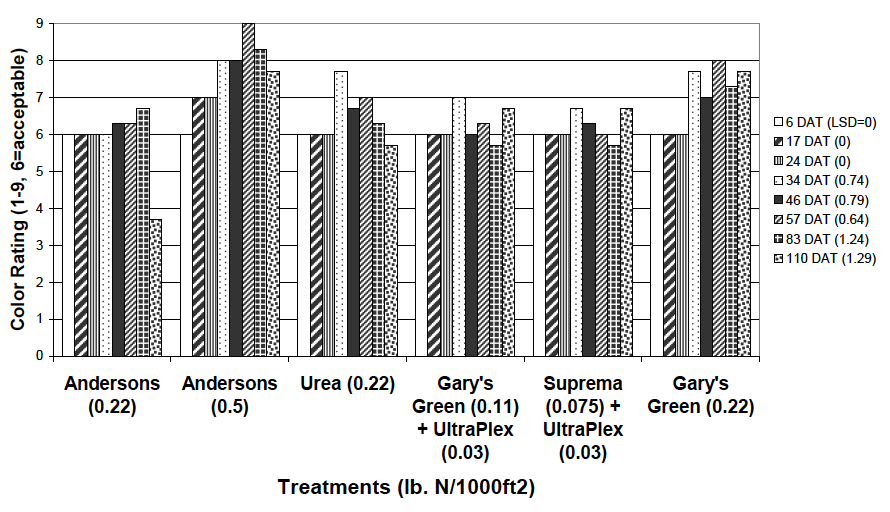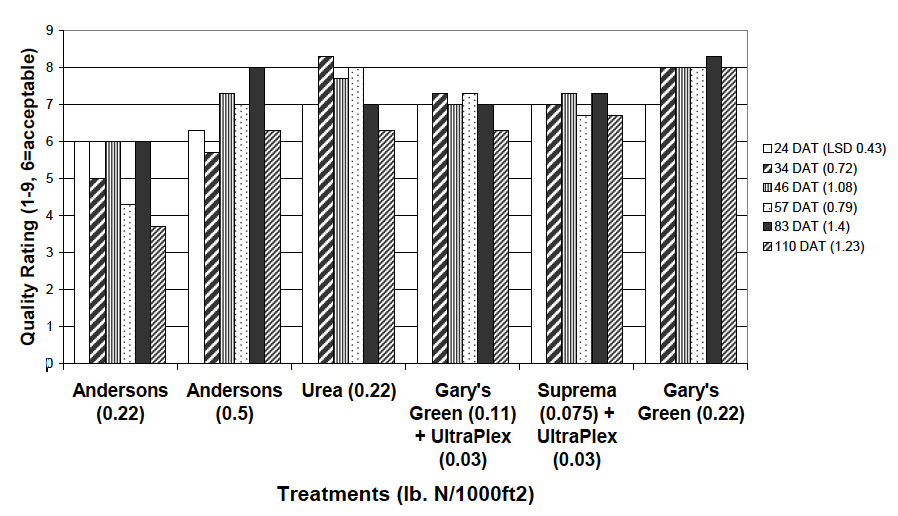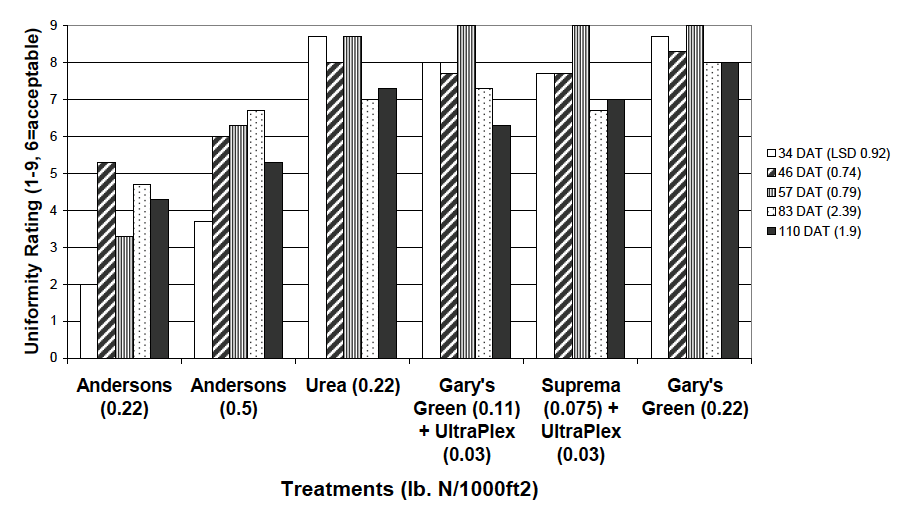Foliar and Granular Nutrition of a Sand Based Sports Turf Field
Foliar and Granular Nutrition of a Sand Based Sports Turf Field R.E. Gaussoin and R.M. Goss
Research experiment was conducted in 2004 at the John Seaton Anderson Turf and Ornamental Research Center near Mead, NE to evaluate several foliar fertilizers for improved Kentucky bluegrass quality. Experiments were performed on a 1 year old stand of Rutgers Kentucky bluegrass blend grown on a 90:10 (v/v) sand:Dakota reed-sedge peat. Plot size was 5’ x 10’ with initial treatments applied on June 25, 2004. All liquid applications were made with a CO2 driven backpack sprayer equipped with a 8002V flat-fan nozzle on 2 wk intervals:
|
Anderson’s Golf Products 21-3-20 (granular) |
0.22 lb. N/1000ft2 |
|
Anderson’s Golf Products 21-3-20 (granular) |
0.5 lb. N/1000ft2 |
|
Urea 46-0-0 (solution) |
0.22 lb. N/1000ft2 |
|
GRIGG™ Gary’s Green 18-3-4 (solution) + GRIGG Ultraplex 5-0-3 (solution) |
0.11 lb. N/1000ft2 + 0.03 lb. N/1000ft2 |
|
GRIGG Suprema 12-0-12 (solution) + GRIGG Ultraplex 5-0-3 (solution) |
0.075 lb. N/1000ft2 + 0.03 lb. N/1000ft2 |
|
GRIGG Gary’s Green 18-3-4 (solution) |
0.22 lb. N/1000ft2 |
The two granular fertilizer applications represent both an N rate similar to the foliar-applied fertilizers (0.22 lb N/1000ft2) and a recommended use rate as provided by the supplier (0.5 lb N/1000ft2). Solubilized urea was used as a treated control treatment at an N rate similar to other foliar-applied fertilizers.
The highest color ratings were consistently given to Kentucky bluegrass treated with granular Andersons Golf Products 21-3-20 when applied at 0.5 lb N/1000ft2 (Figure 1). However, the color was not uniform throughout the treated area as was evident with any of the foliar applied fertilizers (Figure 2). Areas treated with Gary’s Green applied at 0.22 lb N/1000ft2 received color ratings similar to the high rate of Andersons 21-3-20 and urea applied at 0.22 lb N/1000ft2 up to 46 days after initial treatment. At 57 days after treatment, Kentucky bluegrass treated with Gary’s Green at 0.22 lb N/1000ft2 had
better color ratings than urea. All foliar applied fertilizers provided for better color uniformity than granular applications throughout the experiment.
Early in the experiment, urea and Gary’s Green applied at 0.22 lb N/1000ft2 received the highest quality ratings due to the presence of more uniform, darker green, denser turf. At the last rating date, Gary’s Green applied at 0.22 lb N/1000ft2 received better quality ratings than any other treatment.
Results from this experiment indicate that Gary’s Green applied at 0.22 lb N/1000ft2 provided for high quality, dark-green Kentucky bluegrass regardless of time of year. Foliar-applied urea applied at 0.22 lb N/1000ft2 and Andersons 21-3-20 applied at 0.5 lb N/1000ft2 had similar results except results in late fall. Other foliar applied fertilizers did provide for acceptable turfgrass color and quality throughout most of the experiment even though total N rates were half of the urea and Gary’s Green alone treatment and total N rates were a quarter of granular fertilizer applied at the high rate. The granular fertilizer applications did not result in acceptable color uniformity until after multiple applications. Acceptable (and better) color and quality can be achieved with foliar-applied fertilizers at much lower rates of nutrients while still maintaining high color uniformity.

Figure 1. GRIGG™ Post-Growin StudyColor Ratings

Figure 2. GRIGG™ Post-Growin StudyQuality Ratings

Figure 3. GRIGG™ Post-Growin StudyUniformity of Color Ratings